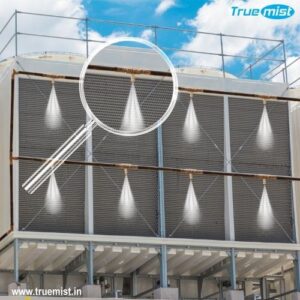Description
High temperatures can cause various problems such as slow manufacturing processes, machinery damage, poor air circulation, bacterial growth, and health issues like nausea and infections. Moreover, it can pose a potential risk of fire and explosions in commercial places such as gas stations, industries, and shops. To address this issue, a mist cooling system is an effective safety measure.
For instance, the high-pressure mist cooling system of petrol and diesel service stations employs a high-pressure pump and fine nozzles to produce tiny water droplets that quickly evaporate, reducing the temperature. The nozzles are designed based on fluid mechanics principles, and the water is delivered through high-pressure pipelines. The manufacturing process of the nozzles requires advanced technology, making them expensive.
The high-pressure mist system creates ultra-small droplets of 5-10 microns, enhancing the evaporation efficiency and humidity levels in the air, thus reducing harmful dust particles and purifying the air. The system is designed to produce a fine mist that does not create water droplets, making it easy to transport over long distances. When combined with large axial fans, it can significantly improve air circulation, thereby enhancing the system's overall effectiveness.
Essential Components of a Misting System
Misting systems have been in use for nearly 30 years as a form of evaporative cooling technology, alongside wetted media and wet compression systems. The key components of a fogging system include atomizing nozzles, which are strategically placed within the inlet air duct to create fog. In addition to the nozzles, the system also requires a programmable logic controller (PLC) and high-pressure pumps to operate effectively. Together, these components work in tandem to generate the cooling fog effect.
How the mist generates
Mist cooling system generates mist by introducing fine water droplets into the inlet air. These droplets are typically between 20 to 40 microns in size, depending on ambient conditions and the desired evaporation time. The water is pressurized and sent through atomizing nozzles that break it down into tiny droplets. These droplets are then carried by air and evaporate quickly, absorbing heat from the surrounding air and creating a cooling effect. The size of the droplets can be adjusted depending on the specific needs of the environment. Overall, the system relies on a precise balance of water pressure, nozzle design, and environmental conditions to create the desired fogging effect.
Key Components for an Optimal Misting System
The effectiveness of a misting system for air cooling depends on several key elements. One crucial factor is the design of the misting nozzles. For optimal performance, the impaction pin must be of the highest quality and specifications. The nozzles themselves should be made of 316-stainless steel to ensure long-lasting and reliable operation. Additionally, pump design is equally important, with positive displacement pumps featuring stainless steel heads being the preferred option.
Beyond these design considerations, the performance of a misting system is heavily influenced by environmental factors. In humid weather conditions, the system may not perform as efficiently. While cost is a consideration, it's essential to prioritize predictable performance when choosing a misting system.
Ultimately, the need for a misting system goes beyond the benefits of comfort and safety, as it can also mitigate fire hazards during hot summer months. As climate change continues to affect global weather patterns, investing in a misting system becomes an even more critical option.





